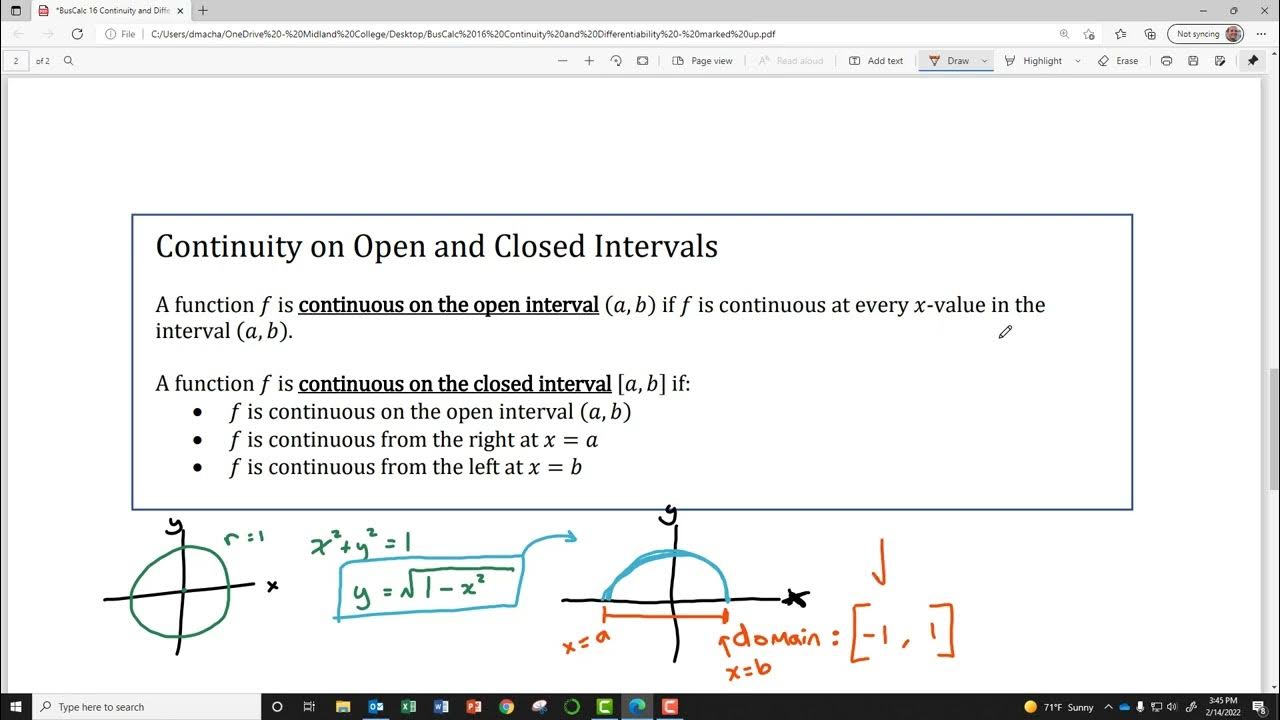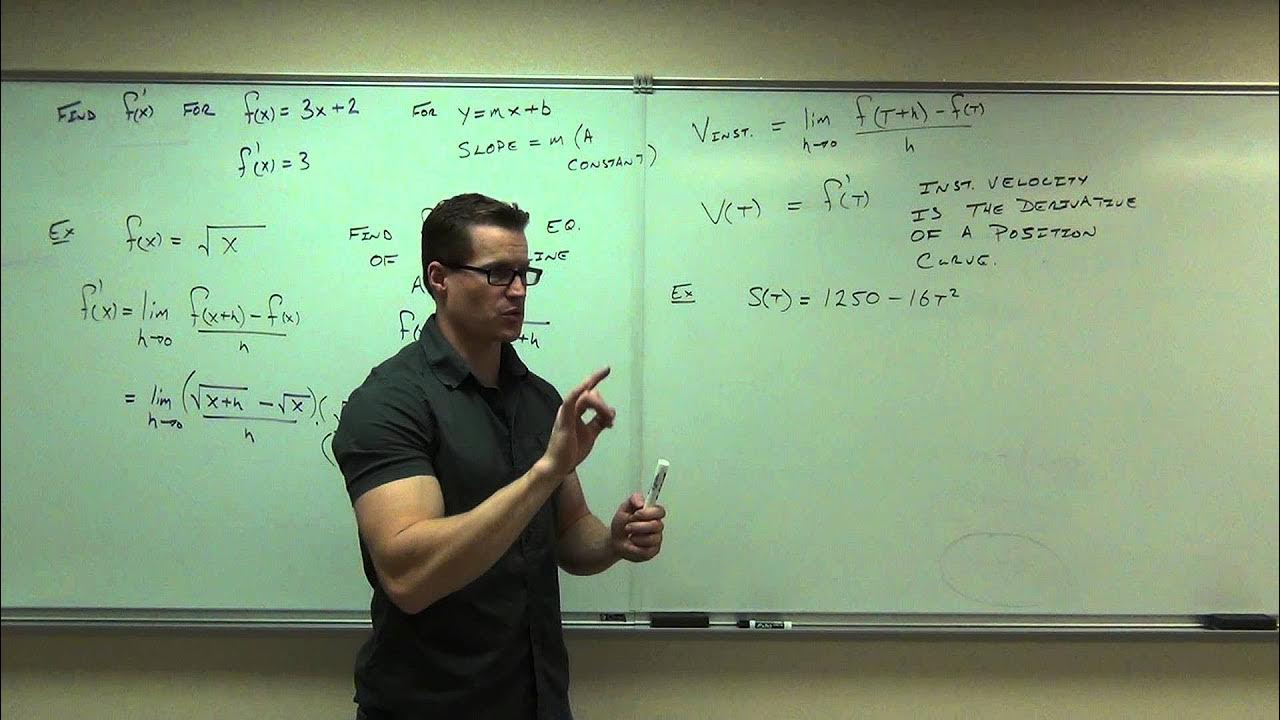Differentiable Functions
TLDRThis video script delves into the concept of differentiability in calculus, explaining that a function is differentiable at a point if its derivative exists. It emphasizes the importance of differentiability in various theorems and illustrates it with examples, such as functions with derivatives that exclude certain points like x = -1. The script also clarifies the relationship between differentiability and continuity, stating that while differentiability guarantees continuity, the converse is not always true. It concludes with the significance of understanding the derivative's domain to determine a function's differentiability.
Takeaways
- 📘 A function is considered differentiable at a point if its derivative exists at that point.
- 📚 The property of being differentiable is crucial in calculus for various theorems and conclusions about functions.
- 🔍 To determine differentiability, one must look at the derivative function, F', and see if it exists at a given value.
- 📈 Differentiability at a value implies that the function is differentiable on an open interval if it is differentiable at every point within that interval.
- 🚫 Differentiability excludes points where the derivative does not exist, such as division by zero or taking the square root of a negative number.
- 📊 The function f(x) = 1 / (x + 1) is differentiable for all x except x = -1, where the derivative cannot be calculated due to division by zero.
- 📐 The function g(x) = sqrt(x + 1) is differentiable for all x > -1, as the derivative exists for these values and avoids imaginary numbers.
- 🔄 Differentiability is a stricter condition than continuity; a differentiable function is always continuous, but a continuous function is not necessarily differentiable.
- 🔄 The contrapositive of the differentiability theorem states that if a function is not continuous at a point, then it is also not differentiable at that point.
- 📝 Understanding the domain of the derivative function is essential to determine where the original function is differentiable.
- 🔑 The script emphasizes the importance of distinguishing between the function F and its derivative F' when discussing differentiability.
Q & A
What does it mean for a function to be differentiable?
-A function is differentiable at a point if its derivative exists at that point. This means there is a limit to the ratio of the change in the function's value to the change in its input as the input approaches that point.
What is the relationship between differentiability and the derivative of a function?
-Differentiability is directly tied to the existence of a function's derivative. If the derivative of a function exists at a point, then the function is considered differentiable at that point.
Why is the property of being differentiable important in calculus?
-Differentiability is crucial in calculus because many theorems and techniques assume that the functions being worked with are differentiable. This allows for making certain conclusions about the behavior of the functions.
Can a function be differentiable at every point on a closed interval?
-No, a function is said to be differentiable on an open interval, which does not include the endpoints. A closed interval would require the function to be differentiable at the endpoints as well, which is not guaranteed by the definition of differentiability.
What does it mean for a function to be differentiable on an open interval?
-A function is differentiable on an open interval if it is differentiable at every point within that interval. The interval is represented with parentheses to indicate that the endpoints are not included.
How does the function f(x) = 1/(x + 1) demonstrate differentiability?
-The function f(x) = 1/(x + 1) is differentiable for all x except x = -1, where the derivative would involve division by zero. The derivative f'(x) = -1/(x + 1)^2 exists for all other values of x.
What is the interval notation for the function f(x) = 1/(x + 1) in terms of differentiability?
-The interval notation for the differentiability of f(x) = 1/(x + 1) is (-∞, -1) ∪ (-1, ∞), indicating that the function is differentiable everywhere except at x = -1.
What is the relationship between differentiability and continuity?
-Differentiability implies continuity. If a function is differentiable at a point, it is also continuous at that point. However, continuity does not guarantee differentiability.
What is the contrapositive of the theorem stating that differentiability implies continuity?
-The contrapositive of the theorem is: if a function is not continuous at a point, then it is not differentiable at that point. This provides a way to show that a function is not differentiable by showing it is not continuous.
Why is it important to distinguish between a function and its derivative when discussing differentiability?
-It's important to distinguish because the existence of the derivative (denoted as f'(x)) at a point is what determines if the original function (f(x)) is differentiable at that point. The properties of the derivative directly influence the differentiability of the function.
How does the function g(x) = sqrt(x + 1) demonstrate differentiability?
-The function g(x) = sqrt(x + 1) is differentiable for all x greater than -1. Its derivative g'(x) = 1/(2*sqrt(x + 1)) exists for these values, indicating that the function is differentiable in the interval notation (-1, ∞).
Outlines
📚 Understanding Differentiability
This paragraph introduces the concept of differentiability in calculus, emphasizing its importance for drawing conclusions about functions. It explains that a function f is differentiable at a number a if the derivative f'(a) exists, which is a limit. The paragraph clarifies that differentiability at a point means the derivative can be calculated there. It also introduces the idea of a function being differentiable on an open interval, which means it is differentiable at every point within that interval, excluding the endpoints. The paragraph concludes with an example of a function f(x) = 1/(x+1), explaining that it is differentiable everywhere except x = -1, where the derivative would involve division by zero.
🔍 Differentiability and Continuity
This paragraph delves into the relationship between differentiability and continuity, two fundamental concepts in calculus. It clarifies that if a function f is differentiable at a point a, then it is also continuous at that point, making differentiability a stricter condition than continuity. However, the converse is not true; a continuous function is not necessarily differentiable. The paragraph also introduces the contrapositive of the theorem, stating that if a function is not continuous at a point, then it is not differentiable there. The importance of understanding the direction of this theorem and its contrapositive is highlighted, especially for future studies in calculus. The paragraph uses the function g(x) = sqrt(x+1) as an example to illustrate these concepts, noting that the derivative exists for x > -1, thus the function is differentiable in the interval (-1, ∞).
Mindmap
Keywords
💡Differentiable
💡Derivative
💡Open Interval
💡Continuity
💡F'(x)
💡Limit
💡Domain
💡Square Root
💡Imaginary Number
💡Interval Notation
💡Theorem
Highlights
A function is differentiable if the derivative exists, which is a key property in calculus.
Differentiability is assumed in several calculus theorems to make conclusions about functions.
A function f is differentiable at a number a if the limit for its derivative exists.
Differentiability at a value means the derivative limit is defined.
A function is differentiable on an open interval if it's differentiable at every value within that interval.
Example given: f(x) = 1/(x+1) is differentiable except at x = -1 where the derivative does not exist.
Differentiability of a function is determined by the existence of its derivative formula.
Interval notation is used to express where a function is differentiable, excluding points where the derivative does not exist.
Differentiability implies the function's derivative exhibits certain properties at those points.
Another example: g(x) = sqrt(x+1) is differentiable for x > -1, as its derivative exists in that domain.
The derivative's domain must be understood to determine where the original function is differentiable.
Differentiability is a stricter condition than continuity in the context of functions.
If a function is differentiable at a point, it is also continuous at that point.
The contrapositive of the differentiability theorem states that if a function is not continuous, it is not differentiable.
Understanding the direction of the differentiability theorem and its contrapositive is crucial for further calculus studies.
Differentiability is a significant concept that impacts the study of calculus and the properties of functions.
Transcripts
Browse More Related Video

BusCalc 16 Continuity and Differentiability

Calculus 1 Lecture 2.1: Introduction to the Derivative of a Function

Continuity and Differentiability

Smoothing a Piece-wise Function | MIT 18.01SC Single Variable Calculus, Fall 2010

AP Calculus AB: Lesson 2.5 Differentiability

Proof: Differentiability implies continuity | Derivative rules | AP Calculus AB | Khan Academy
5.0 / 5 (0 votes)
Thanks for rating: